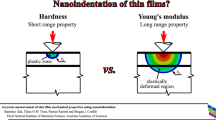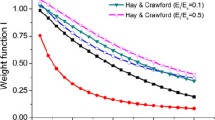Abstract
Substrate influence is a common problem when using instrumented indentation (also known as nanoindentation) to evaluate the mechanical properties of thin films. In this work, finite element analysis was used to develop an ad hoc model that predicts the substrate influence when testing thin dielectric films on silicon. The model was evaluated experimentally using three sets of films that were nominally the same except for thickness. Using the model significantly reduced the measurement error for the thinnest films (>250 nm) by accurately accounting for the influence of the substrate. The model also significantly reduced the measurement uncertainty, because properties were evaluated using larger indents that would normally be unduly affected by the substrate. The process for developing this model may be useful in developing other ad hoc models for analyzing film-substrate systems.
Similar content being viewed by others
Abbreviations
- k:
-
Permittivity or dielectric constant
- err (E*OP):
-
Error in the measured quantity, E*OP
- A:
-
Contact radius
- t:
-
Film thickness
- E r :
-
Reduced modulus
- E in :
-
Value of E used as input to the finite element simulation
- E:
-
Young’s modulus; subscripts “f” and “s” refer to film and substrate, respectively
- E*OP:
-
E, evaluated using Oliver-Pharr data analysis, uncorrected
- E OP :
-
E of film, evaluated using Oliver-Pharr data analysis, corrected for substrate influence
- E OP-bulk :
-
E of a bulk sample of the film material, evaluated by simulation and application of Oliver-Pharr analysis
- E OP-sub :
-
E of substrate, evaluated using Oliver-Pharr data analysis
- E TAN :
-
Slope of bilinear stress-strain curve after yield
- v:
-
Poisson’s ratio
- sy:
-
Yield stress
- A:
-
Projected cross-sectional area of indenter
- d:
-
Distance from the apex along the axis of the indenter
References
W.C. Oliver and G.M. Pharr: An improved technique for determining hardness and elastic modulus using load and displacement sensing experiments. J. Mater. Res. 7, 1564 (1992).
M.F. Doerner and W.D. Nix: A method for interpreting the data from depth-sensing indentation instruments. J. Mater. Res. 1, 601 (1986).
R.B. King: Elastic analysis of some punch problems for a layered medium. Int. J. Solids Struct. 23, 1657 (1987).
H. Gao, C-H. Chiu, and J. Lee: Elastic contact versus indentation modeling of multi-layered materials. Int. J. Solids Struct. 29, 2471 (1992).
J. Menčík, D. Munz, E. Quandt, E.R. Weppelmann, and M.V. Swain: Determination of elastic modulus of thin layers using nanoindentation. J. Mater. Res. 12, 2475 (1997).
H. Song: Selected mechanical problems in load and depth sensing indentation testing. Ph.D. Thesis, Rice University, Houston, TX, 1999.
A. Rar, H. Song, and G.M. Pharr: Assessment of new relation for the elastic compliance of a film-substrate system, in Thin Films: Stresses and Mechanical Properties IX, edited by C. S. Ozkan, L.B. Freund, R.C. Cammarata, and H. Gao (Mater. Res. Soc. Symp. Proc. 695, Warrendale, PA, 2002), L10.10, pp. 431–438.
H. Xu and G.M. Pharr: An improved relation for the effective elastic compliance of a film/substrate system during indentation by a flat cylindrical punch. Scr. Mater. 55(4), 315 (2006).
S. Bec, A. Tonck, J.M. Georges, E. Georges, and J.L. Loubet: Improvements in the indentation method with a surface force apparatus. Philos. Mag. A 74, 1061 (1996).
S. Roche, S. Bec, and J.L. Loubet: Analysis of the elastic modulus of a thin polymer film, in Mechanical Properties Derived from Nanostructuring Materials, edited by D.F. Bahr, H. Kung, N.R. Moody, and K.J. Wahl (Mater. Res. Soc. Symp. Proc. 778, Warrendale, PA, 2003), U4.8, pp. 117–122.
J.C. Hay, A. Bolshakov, and G.M. Pharr: A critical examination of the fundamental relations in the analysis of nanoindention data. J. Mater. Res. 14, 2296 (1999).
Author information
Authors and Affiliations
Corresponding author
Rights and permissions
About this article
Cite this article
Hay, J. Measuring substrate-independent modulus of dielectric films by instrumented indentation. Journal of Materials Research 24, 667–677 (2009). https://doi.org/10.1557/jmr.2009.0132
Received:
Accepted:
Published:
Issue Date:
DOI: https://doi.org/10.1557/jmr.2009.0132




